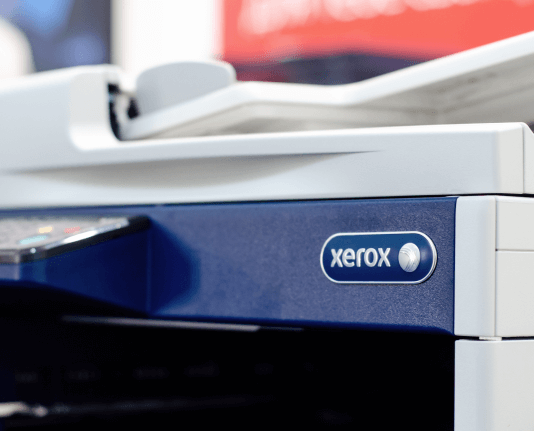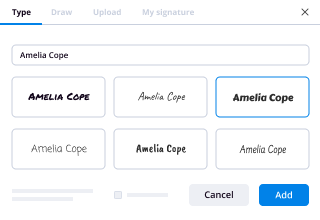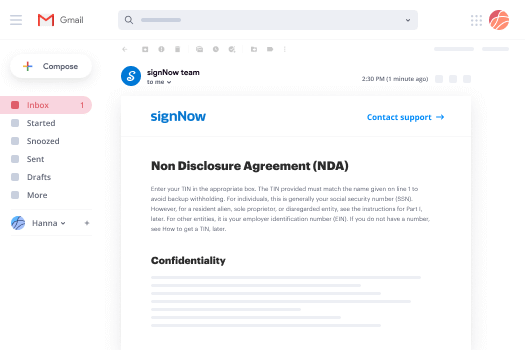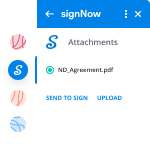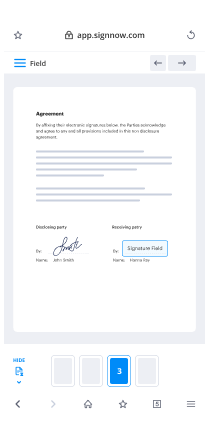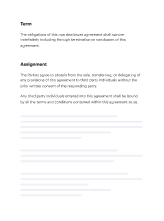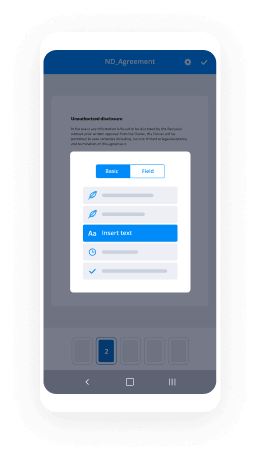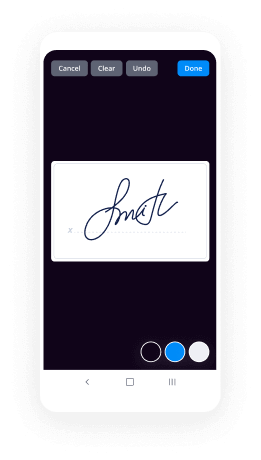Can I Use eSign in Word
Contact Sales
Make the most out of your eSignature workflows with airSlate SignNow
Extensive suite of eSignature tools
Robust integration and API capabilities
Advanced security and compliance
Various collaboration tools
Enjoyable and stress-free signing experience
Extensive support
Keep your eSignature workflows on track
Our user reviews speak for themselves






Is it possible to use a pen on Word to autograph my name?
If you're curious, 'Is it possible to use a pen on Word to autograph my name?' the response is affirmative, but there's a more effective method to manage digital signatures. airSlate SignNow provides an advanced solution for signing documents electronically, enabling you to simplify the signing procedure without the inconvenience of printing or scanning. This guide will lead you through the process of using airSlate SignNow for your signing requirements.
Is it possible to use a pen on Word to autograph my name?
- Launch your web browser and go to the airSlate SignNow homepage.
- Establish a new account with a complimentary trial or log into your current account.
- Select the document you intend to sign or share for signatures by uploading it.
- Convert commonly used documents into templates for future applications.
- Access your uploaded document to make necessary adjustments, such as adding fillable fields or other information.
- Add your signature and create signature fields for any involved recipients.
- Click on 'Continue' to set up the eSignature invitation and send it out.
To sum up, airSlate SignNow streamlines the process of signing documents digitally with its intuitive interface and extensive features. Organizations can greatly improve their document management processes while conserving time and resources.
Prepared to enjoy the advantages of electronic signatures? Register for airSlate SignNow today and find out how it can revolutionize your document signing experience!
How it works
Rate your experience
-
Best ROI. Our customers achieve an average 7x ROI within the first six months.
-
Scales with your use cases. From SMBs to mid-market, airSlate SignNow delivers results for businesses of all sizes.
-
Intuitive UI and API. Sign and send documents from your apps in minutes.
A smarter way to work: —how to industry sign banking integrate
FAQs
-
Can I use a pen on Word to sign my name digitally?
Yes, you can use a pen on Word to sign your name digitally. By utilizing the drawing tools in Microsoft Word, you can create a signature that mimics handwriting. However, for a more secure and legally binding option, consider using specialized eSigning solutions like airSlate SignNow.
-
What are the benefits of using airSlate SignNow instead of Word for signing documents?
While you can use a pen on Word to sign your name, airSlate SignNow offers enhanced security features, compliance with eSignature laws, and easy document tracking. This means your signatures are not only visually appealing but also legally binding and secure. Plus, airSlate SignNow integrates seamlessly with various applications for streamlined workflows.
-
Is airSlate SignNow affordable for small businesses?
Absolutely! airSlate SignNow provides a cost-effective solution for businesses of all sizes. With flexible pricing plans, you can choose a package that fits your needs without breaking the bank, making it a practical choice compared to just using Word to sign documents.
-
Can I use airSlate SignNow on mobile devices?
Yes, airSlate SignNow is fully optimized for mobile devices, allowing you to sign documents on the go. This flexibility means you don’t have to rely solely on Word to sign your name, as you can access your documents from anywhere and sign them quickly using your smartphone or tablet.
-
What integrations does airSlate SignNow offer?
airSlate SignNow integrates with many popular applications like Google Drive, Dropbox, and Salesforce. This means you can easily manage your documents and signatures without switching between platforms, which is a signNow advantage over simply using Word to sign your name.
-
How does airSlate SignNow ensure the security of my signatures?
airSlate SignNow employs advanced encryption and security protocols to protect your signatures and documents. While you can use a pen on Word to sign your name, it may not offer the same level of security as a dedicated eSigning platform, making airSlate SignNow a safer choice for sensitive documents.
-
Can I customize my signature in airSlate SignNow?
Yes, airSlate SignNow allows you to customize your signature according to your preferences. You can create a signature that resembles your handwritten name, offering a personal touch that you might not achieve by just using a pen on Word to sign your name.
-
What are the best productivity tools?
My TOP list is as follows:1. Communication tool - SlackOur team has been successfully using Skype for quite a while, and this is a way out for some teams, both small and bigger ones, but Slack is more convenient to use for IT teams, for marketers, sales people, and other industry-specific teams.2. Time tracking tool - ClockifyI like Clockify – it’s very simple, you create a task, you start tracking your time, you stop when you’re done, AND you can also check how much time you spent weekly on each working task.3. To do list – Trello boardsThe next tool I LOVE is Trello. This is a perfect one for outlining your day to day tasks, your future tasks, mapping out your ideas, sharing them with your team members, and so on.4. G Suite.No comments - couldn’t do without it.5. CalendlyIF you have a large number of meetings daily.6. Project management toolThroughout my years in IT I have met and used different PM tools, like Jira, YouTrack, Asana, and TeamGantt. And I must say that each one is good for its own purpose – so you simply choose the one that work best for you.7. Reporting tool - ExcelI have not used any specific reporting tool: I use Excel tables, both on Google drive and offline Excel files.8. CanvaNo comments :) Saves a fortune on a designer for those SMW owners whose budget is limited.See the full version of my tips here:8 BEST Tools for Remote Professionals
-
What would be some great apps for the Apple Watch?
Deliveries is a good app, it has a complication which you can add to your watch face. A complication is a widget that can be placed in different areas of the watch face. Deliveries will show you how many days left or just gives you quick access to open it.Cheat sheet is good for Passwords or pins and also comes with a complication. If you are in the UK Natwest and Barclays apps are good as you can check your bank balance from your watch. With Natwest you can use the watch to get money from an ATM without needing to put your Bank Card in the ATM.Trello is good too on the watch. You can add voice notes to cards. One Note can also add voice notes.Try out the camera app for the odd occasion where you need to take a selfie at a distance and have the camera propped up, you can check your watch to see if you are in frame and set a countdown timer to take your picture.
-
Why do British people prefer to use "ae" instead of "e" in words like "haemoglobin"?
Because we spell it as it should be. Ligatures, like ‘æ’ and ‘œ’ are pronounced differently to ‘a’, ‘e’, or ‘o’ on their own… and slightly differently from ‘ae’ and ‘oe’ as separate letters. In fact, ‘æ’ and ‘œ’are considered as separate individual letters, in the same way as accented and modified letters (like à, á, â, é, è, ï, ø, ô, ß, ü, ñ, ç, č, š, etc.) are in other languages… some of which have made their way into English as in ‘naïve’, café, ‘resumé’ (to differentiate it from ‘resume’) and ‘clientèle’.US English seems to be particularly lazy about spelling different words differently (we’ll use a ‘cheque’ to pay for something, but we ‘check’ the quality of the item - I hope we’re all educated enough describe someone born in Prague or Brno as being Czech.)I’m not sure whether America modified the spelling to match a common mispronunciation of words, or whether the American pronunciation followed the changes in spelling made by that illiterate idiot, Webster. - For example ‘pædophile’ is pronounced in America as ‘ped’ (to rhyme with red) ‘o’ ‘file’. Elsewhere, the ‘æ’ is pronounced as a sound halfway between a short ‘a’ and a short ‘e’ (separately written, as ‘ae’, the paired letters should be pronounced as halfway between a long ‘a’ and a ‘long ‘e’). The ‘œ’ ligature and ‘oe’ pairing follows the same guidelines. ‘Fœtus’ or ‘fetus’, and ‘mediæval’ or ‘medieval’ are other examples.How do Americans spell the few words adopted into English which are given different spellings to reflect their gender? (as many words are in other languages)… I refer to words like ‘fiancé’ (male) and ‘fiancée’ (female), or ‘blond’ (male), and ‘blonde’ (female). Does American English differentiate?
-
Common Admission Test (CAT): How do I improve my QA score? I feel the questions i practice are much easier than the ones which c
If your concepts are really clear, you should not have any problem in walking through CAT QA questions. 72 percentile doesn't say "clear concepts" in any way. I would suggest you start preparing for the long haul - give yourself time and target CAT next year. You can work in the meanwhile, which will only improve your chances of getting in.To start, get familiar with basic theory. Pick up easy questions and, instead of just getting the answer, make sure you understand how you got there. Once you know how, you will start getting to the what without much effort. After that, it's only a matter of practice. For heaven's sake, don't memorize the gazillion formulae most coaching centers will throw at you. You'll never remember them when you most need to, and will be left high and dry on the day. I would strongly advise solving basic 11th and 12th level maths for trigonometry, combinatorics, set theory and so on, before moving on to solved CAT papers before 2008. 2009 onwards, CAT went online and most questions you'll find solved in textbooks are from memory, that too of those who took the test. You can't trust them. In any case, even the before 2008 criterion allows you to choose from a large set of actual CAT papers. You may also refer to the study material provided by TIME, CL or IMS. I find the questions decent.In CAT, a 70% score will get you a percentile of 99.5+ any day, so make sure you know that you can give up 30% of the questions and spend more time on the 70% that you might be able to solve with relative ease. The mocks are slightly tougher than the final test, and a select few people who're very serious about the CAT take those, so your percentile is bound to be lower. You'd do best to progress slowly. Once you really have your concepts clear and cemented in your brain, you'll find it easy to build up speed. In any case, you have 70 mins for 22 questions - remember, you're willing to leave 8-9 questions - which gives you more than 3 mins per question.But these strategies only create decimal point differences. I have never scored under 99.5 in QA in the CAT, primarily because I ate, drank and slept that sort of maths at one point of time. I wouldn't advise that, but you need to work your way up from the basics, if you want to get into the top 10 B-schools in the country.Thanks for the A2A.
-
Is 'ü' pronounced the same in every language it's used in or does every language have a different way?
No, it’s not.When people mention ü, they are usually thinking of German. In standard German, ü stands for either /yː/, as in Düker [ˈd̥yːkʰɐ], or /ʏ/, as in Müller [ˈmʏlɐ]. German treats these two vowels as a long-short pair. Whether ü reads as long /yː/, or as short /ʏ/ can mostly be worked out from spelling (though there are exceptions).These vowels — [y] and [ʏ] — are high front rounded vowels. To make them, pronounce the high front unrounded vowels [i] and [ɪ] (as in beat and bit, respectively), but round (compress) your lips as you would for [u] (as in food).All languages that have borrowed the convention of using dots on top of letters from German, use ü for similar high front rounded vowels. Examples includeHungarian: in words like üt [y̠t],Anatolian and Azerbaijani Turkish: in words like Türk [tʰʏɾcʰ],in addition to Estonian, Turkmen, Crimean Tatar (in Turkey) etc. This sort of use of the double dots is often called “umlaut” in everyday parlance, even though linguists prefer to reserve the term for a specific phonological property of German and related languages (including those that don’t use the grapheme ü).Even in languages that do not use a Roman writing system as their standard, ü occurs for a high front rounded vowel (if it exists) in some established Romanization schemes. The most famous example is Pīnyīn for Mandarin, where ü stands for /y/ after n and l, as in the (relatively) common last name Lǚ (sometimes written Lv̌ or Lv, owing to typographical constraints, if not simplified to the incorrect Lŭ or Lu). Other examples are Zamanälif [zɒmɑnæˈlif] for Volga Tatar and the Uyghur Latin alphabet.However, that’s not the only use of the double dots. Spanish and Catalan (and possibly, other languages of the area) use ü to mark that a u between an orthographic g and i or e is to be pronounced as [w], and not left “silent”. For example, compare *gue [ɣ̞e̞] and *güe [ɣ̞we̞]. Note that the use of the “silent” u in *gue actually does serve a purpose. If it were simply spelled ge, the g would be pronounced differently, as /x/, because it precedes a front vowel e (or i). As a proper example, consider the name of the country Nicaragua [nikäˈɾäɣ̞wä]. Because the vowel sign following gu is a, the “gwa” presents no major problem in being represented by the letters. Now a person from Nicaragua is nicaragüense [nikäɾäˈɣ̞we̞ns̠e̞]. Without the dots here, we would just get [nikäɾäˈɣ̞e̞ns̠e̞] (without the [w] sound).French uses the double dots for the same reason, but also to mark a vowel hiatus (formerly used for that purpose in English too). Compared to ï, the use of ü is rare, but Wikipedia mentions a few uncommon words like Emmaüs [emäˈys].In addition to these standard uses, ü is often employed by linguists for languages without a standardized Roman orthography to mark certain vowels in ad hoc Roman alphabets. Usually, the vowel being represented is [y] or [ʏ] (keeping with the German use), but every so often, other sounds may be represented. For example, in some publications on Kashmiri, /ɪ̈/ is written with ü.[See also the informative comments below.]
-
What are some interesting startups in the education space? Why are they interesting?
Here's one noteworthy peer-to-peer education model in Paris newly opened in November 2013 to students around the world, tuition FREE! — École 42 — The school, housed in a former government building used to educate teachers (ironically enough), was started by Xavier Niel. The founder and majority owner of French ISP Free, Niel is a billionaire many times over. He’s not well known in the U.S., but here he is revered as one of the country’s great entrepreneurial successes in tech. This French Tech School Has No Teachers, No Books, No tuition — And It Could Change EverythingAbove: Nicolas Sadirac, the director of the ambitious, free, French tech school Ecole 42. Image Credit: Dylan Tweney/VentureBeatNicolas Sadirac, a French entrepreneur and educator, is the school’s director. Before École 42 he ran Epitech, a well-regarded, private, for-profit school that trained software engineers.PARIS — École 42 might be one of the most ambitious experiments in engineering education.It has no teachers. No books. No MOOCs. No dorms, gyms, labs, or student centers. No tuition.And yet it plans to turn out highly qualified, motivated software engineers, each of whom has gone through an intensive two- to three-year program designed to teach them everything they need to know to become outstanding programmers.The school, housed in a former government building used to educate teachers (ironically enough), was started by Xavier Niel. The founder and majority owner of French ISP Free, Niel is a billionaire many times over. He’s not well known in the U.S., but here he is revered as one of the country’s great entrepreneurial successes in tech. He is also irrepressibly upbeat, smiling and laughing almost nonstop for the hour that he led a tour through École 42 earlier this week. (Who wouldn’t be, with that much wealth? Yet I have met much more dour billionaires before.) Niel started École 42 with a 70 million euro donation. He has no plans for it to make money, ever.“I know one business, and that’s how to make software,” Niel said. “I made a lot of money and I want to give something back to my country,” he explained.To make the school self-sustaining, he figures that future alumni will give back to their school, just as alumni of other schools do. If a few of them become very rich, as Niel has, perhaps they, too, will give millions to keep it going.The basic idea of École 42 is to throw all the students — 800 to 1,000 per year — into a single building in the heart of Paris, give them Macs with big Cinema displays, and throw increasingly difficult programming challenges at them. The students are given little direction about how to solve the problems, so they have to turn to each other — and to the Internet — to figure out the solutions.The challenges are surprisingly difficult. One student I talked with was coding a ray tracer and building an emulation of the 3-D dungeon in Castle Wolfenstein within his first few months at the school. Six months earlier, he had barely touched a computer and knew nothing of programming. He hadn’t even finished high school.In fact, 40% of École 42′s students haven’t finished high school. Others have graduated from Stanford or MIT or other prestigious institutions. But École 42 doesn’t care about their background — all it cares about is whether they can complete the projects and move on. The only requirement is that they be between the ages of 18 and 30.“We don’t ask anything about what they’ve done before,” Niel said.Yet École 42 is harder to get into than Harvard: Last year, 70,000 people attempted the online qualification test. 20,000 completed the test, and of those, 4,000 were invited to spend four weeks in Paris doing an intensive project that had them working upwards of 100 hours a week on various coding challenges. In the end, 890 students were selected for the school’s inaugural class, which began in November, 2013. (The average age is 22, and 11 percent of the first class is female.)890 students out of 70,000 applicants means an acceptance rate a little north of 1%, or if you only count those who completed the test, 4.5%. By contrast, Harvard accepts about 6% of its applicants. And, even with financial aid, it charges a whole lot more than ZERO for its classes.The upshot: If it works, the school’s course of education will produce coders who are incredibly self-motivated, well-rounded in all aspects of software engineering, and willing to work hard. (The four-week tryout alone, with its 100-hour weeks, blows away the French government’s official 35-hour-work week.)All of École 42′s projects are meant to be collaborative, so the students work in teams of two to five people. At first glance, the École’s classrooms look a little bit like a factory floor or a coding sweatshop, with row after row of Aeron-style chairs facing row after row of big monitors. But a closer look reveals that the layout is designed to facilitate small-group collaboration, with the monitors staggered so that students can easily talk to one another, on the diagonals between the monitors or side by side with the people next to them. Students can come and go as they please; the school is open 24 hours a day and has a well-appointed cafeteria in the basement (with a wine cellar that can hold 5,000 bottles, just in case the school needs to host any parties).Students share all of their code on Github (naturally). They communicate with one another, and receive challenges and tests, via the school’s intranet. Everything else they figure out on their own, whether it means learning trigonometry, figuring out the syntax for C code, or picking up techniques to index a database.Tests are essentially pass-fail: Your team either completes the project or it doesn’t. One administrator compared it to making a car: In other schools, getting a test 90% right means an A; but if you make a car with just three out of four wheels, it is a failure. At École 42, you don’t get points for making it part way there — you have to make a car with all four wheels.The no-teachers approach makes sense, as nearly anything you need to know about programming can now be found, for free, on the Internet. Motivated people can easily teach themselves any language they need to know in a few months of intensive work. But motivation is what’s hard to come by, and to sustain — ask anyone who has tried out Codecademy but not stuck with it. That has prompted the creation of “learn to code” bootcamps and schools around the world. École 42 takes a similar inspiration but allows the students to generate their own enthusiasm via collaborative (and somewhat competitive) teamwork.Sadirac and Niel say that some prestigious universities have already expressed interest in the school’s approach. The two are considering syndicating the model to create similar schools in other countries.But even if they never expand beyond Paris, École 42 could become a signNow force in software education. France already has a reputation for creating great engineers (in software as well as in many other fields).If École 42 adds another thousand highly-motivated, entrepreneurial software engineers to the mix every year, it could very quickly accelerate this country’s competitiveness in tech.And the model will force schools like Harvard to make an extra effort to justify their high tuitions. If you can get training like this for free, and you want to be a software engineer, why go to Harvard?(news link:) This French tech school has no teachers, no books, no tuition -- and it could change everything
-
How do you teach children phonics?
Phonics is a necessary part of any good method of teaching children to read. Teaching Children phonics and helping them develop phonemic awareness is the key to mastering words, which is the first key step toward successful reading. Children need to develop a knowledge of the letters, the sounds represented by the letters, and the connection between sounds created by combining the letters where words are formed. This is an essential part of mastering reading, and enabling children to become independent readers. By learning phonics and phonemic awareness, children gain the ability to pronounce new words, develop clear articulation, improve spelling, and develop self confidence.When it comes to teaching your children to read, it must include three basic principles:1) Reading for the child, whether it's a word, sentence, or story, must appeal to your child's interests.2) Never pressure or force your child into reading, turning it into a negative "event" in their life. It should be a fun, enjoyable, and rewarding experience. This will take ample amounts of patience on the part of the parents, and some creativity.3) Teaching your child to read must begin with the mastery of the phonemes - the individual sounds which makeup the words.The basic process of teaching phonics and phonemic awareness to children includes teaching them the letters and letter sounds; then you teach the child to combine (or blend) various letter sounds together to form words; which is then followed by reading sentences and simple stories. This is a logical progression for children to learn reading, where they develop accuracy in decoding words and pronouncing words. This method of teaching also helps the child to spell correctly. Gradually, the different elements of phonics are combined to produce new words, and leads to the discovery of new words by the child using this process which becomes an "automatic reflex".Teaching phonics to children should take 10 to 15 minutes each day, and these "lessons" should take place in several small sessions each day - such as 4 or 5 session lasting 3 to 5 minutes each. For older pre-school children, lessons can be slightly longer; however, several minutes each session is all that's needed.One way to start teaching phonics to children with with ear training - by helping them develop the understanding that words are made up of smaller units of sounds, or known as phonemes, and when you combine these sounds, a word is formed. You can start this with very short sessions, as already mentioned. A few minutes a day is all that you need. The key, however, is consistency and patience.During these short sessions, sound out words slowly and distinctly. You can do this without even making the child aware that you are trying to teach them. Simply take words from your everyday speaking to your child and include oral blending sounds into your sentences. For example, if you wanted to ask your child to drink his milk, you could say: "Joe, d-r-i-n-k your m-ilk." The words drink and milk are sounded out slowly and distinctly. The level of sound separation can be set by you to increase or lower the difficulty. Thus, if Joe has a tough time figuring out that d-r-i-n-k means drink, you can lower the difficulty by blending the word as dr-ink instead.Alternatively, you could simply pick different words and play blending sounds games with your child. You simply say the sounds of the word slowly, and ask the child try to guess what you are saying.This concept of individual sounds forming words may take some time for your child to grasp. Some children will pick it up quickly, while other children may take longer, but one thing that's certain is that if you keep it up, your child will catch on. Below are some sample words which you can use to play blending sounds activities with your child.J-u-m-p J-umpR-u-n R-unS-i-t S-itS-t-a-n-d St-andM-i-l-k M-ilkS-t-o-p St-opThe first word is more segmented than the second word, and will be more difficult to sound out. Please note that hyphens are used to indicate the letter sounds instead of slashes.ie: J-u-m-p /J/ /u/ /m/ /p/This is done to make things easier to read; however, when you read it, you should not read the names of the letters, but instead say the sounds of the letters. This type of ear training for phonics and phonemic awareness should continue throughout the teaching process, even well after your child have grasped this concept. It can be applied to words with increasing difficulty. Again, please always keep in mind that not all children can readily blend the sounds to hear the word, so you must be patient, and drill this for days, weeks, or even months if needed. Consistency and frequency is the key to success here, and not sporadic binge sessions.
-
If you could, what modifications would you make in the Devanagari script to suit Hindi better?
I am a native Hindi speaker, but having grown up in Canada and the UK I was never educated in Hindi. My grandparents taught me to read and write in Devanagari, and while I am getting better and quicker at it, the laughter from my parents at my initial attempts has definitely left me less amenable to the ‘Devanagari is the most perfect, scientific script’ nonsense that people keep telling me while laughing at my mistakes.From this perspective, there are a number of changes which you could say would make it easier for children, foreigners, and second-gens to learn it, many of which have been raised by others:Marking of schwa-deletion / use of halant (the schwa-deletion diacritic, so seldom used): there are no satisfactory rules to predict how to read things, leading to heteronyms like ‘dharkane’ and ‘dharakne’, both written धड़कनेUse of diacritics to distinguish foreign sounds, particularly ones like z and f which are pretty much embedded phonemes now for most educated speakersFixing weirdly spelled (or alternatively weirdly pronounced) words like ye and vo, which are spelled yaha and vaha respectivelyThese last two are parts of bigger problems:On the first, Devanagari has not really standardised ways of transliterating from Arabic at all – most importantly for letters like ‘ain ع – in the way that it is now standardising approaches to English vowels like [æ] and [ɔ]On the second, the Hindi sequence VhV – that is, a h nestled between any two vowels – is unstable in general, usually resulting in an open vowel like [ɛ] being pronounced in a ‘breathy’ way; this can make the consonant in front of it seem aspirated, but is often unpredictable(my parents – both educated in Hindi in India – had a healthy debate about the correct spelling of the word pronounced kathel ‘jackfruit’ – for the record, per Wiktionary, the answer is katahala कटहल, which is nothing like how it is pronounced)I always used to get tripped up with words like bahut ‘very’, which is usually pronounced something like [bɔht]But the truth is, while all sorts of changes might make Devanagari easier for learners (or ‘more scientific’), they are no really big deals. So Hindi has the odd heteronym, where pronunciation is not predictable (like धड़कने). So what? English has tonnes of those (‘read’ and ‘read’, for instance) and is none the worse for it. Hindi has confusing pronunciation for sequences like VhV – big deal; English has confusing pronunciation for sequences like gh and is absolutely fine.All of these then are reasons to just acknowledge that Hindi’s Devanagari spelling is not ‘scientific’, no matter what nonsense nationalists and schoolteachers spin, and get on with the job of just learning it as it is, warts and all. Put the work in, and we will be fine.What change would I make then?For me, I think Brahmi missed a trick when it never came up with a doubling sign for consonants. Well done to Gurmukhi for recognising that Arabic shaddah or tashdid was, literally, a master-stroke, and creating addak out of it.True, Hindi has fewer geminated consonants than Punjabi does. But nevertheless, it has enough to be really inconvenient when writing in Devanagari. Let’s be honest: ligatures or ‘joraakshar’ are Devanagari’s least well handled element; schwa deletion gets rid of one big set of those, but a doubling sign would get rid of another major chunk.So I would change Devanagari by adding a doubling sign for geminated consonants. Other than that, I think it is fine – not ‘scientific’ or ‘perfect’, but good enough, usually.
-
What are some useful skills I can learn in minutes?
I will post many skills with respect to computers which takes only few minutes to learn.1. MagnifierEver had problem while presenting; To enlarge what's on the screen, to make it more visible, try magnifier.Click on start, then search for magnifier on the search bar. Then click on magnifier.Then select the level to Zoom, you will see enlarged part of the screen just like in the image below.Shortcut: Press Windows+plus to open magnifier directly.2. Turn your Laptop into WiFi Hotspot.Copy the following lines into NotePad and save it as WiFi.batnetsh wlan set hostednetwork mode=allow ssid=WIFI key=password123netsh wlan start hostednetworkNow right click on the file and select "Run as administrator" , automatically WiFi hotspot will be turned ON.You can change the WiFi name by changing ssid=new name and password key=newpasswordImportant - For this to work, your sharing should be on in the network properties for the network/ethernet connection that you want to share through your wifi:Go to Open Network and Sharing Centre ->Change Adapter Settings(On left panel)Your wifi hotspot would be Microsoft Hosted Network Virtual Adaptor in the Network Connections.Go to the properties of the LAN/ethernet/WiFi connection and make the changes accordingly.There you can see the wifi Hotspot network.Your wifi hotspot would be ready.To turn Off the WiFi Hotspot, copy this code in a notepad file and save it as wifistop.bat then run that bat file as "Run as Administrator".netsh wlan stop hostednetwork3. Slide Between windows with awesome 3D flip Animation.Press and hold Winows+Tab to slide over windows.press Windows+shift+Tab to slide in reverse order.4. Subtitles for movies not Synchronized, Just follow this simple trick.Open the video in MPC (Media player classic) and pause the movie at a point, Then Click on View->subresync.Then you will see a window like belowAt a given point click on the line of subtitle which is correct for the scene, Right click on it and select current.The Subtitle will be automatically updated to that point.You can save the modified subtitle by File->Save subtitle.5. Want to hide some Files and Folders.You Might be tired of using File locker software which are difficult to use and ask for registrations.Follow the simple Tip.Open NotePad and paste the following codecls@ECHO OFFtitle Folder Lockerif EXIST "Control Panel.{21EC2020-3AEA-1069-A2DD-08002B30309D}" goto UNLOCKif NOT EXIST Locker goto MDLOCKER:CONFIRMecho Are you sure u want to Lock the folder(Y/N)set/p "cho=>"if %cho%==Y goto LOCKif %cho%==y goto LOCKif %cho%==n goto ENDif %cho%==N goto ENDecho Invalid choice.goto CONFIRM:LOCKren Locker "Control Panel.{21EC2020-3AEA-1069-A2DD-08002B30309D}"attrib +h +s "Control Panel.{21EC2020-3AEA-1069-A2DD-08002B30309D}"echo Folder lockedgoto End:UNLOCKecho Enter password to Unlock folderset/p "pass=>"if NOT %pass%==password123 goto FAILattrib -h -s "Control Panel.{21EC2020-3AEA-1069-A2DD-08002B30309D}"ren "Control Panel.{21EC2020-3AEA-1069-A2DD-08002B30309D}" Lockerecho Folder Unlocked successfullygoto End:FAILecho Invalid passwordgoto end:MDLOCKERmd Lockerecho Locker created successfullygoto End:EndThen save it as Locker.batClick on that BAT file , a New Folder called Locker will be created as shown belowCopy and paste all the Files and Folders that you want to Hide into that Locker Folder.Then click on that BAT file again a CMD promt will appear and ask you permission to lock the files. Just Type Y and press Enter.Now you can see all the files and folders and also the Locker folder disappears.To Unlock all the files and folders, Once again click on that BAT file. You will see a CMD promt then Type password123You will see that Locker Folder appears back.If you want to change the password, Open that BAT file in notepad and search for the word "password123" and replace it with your new Password.6. Turn off Windows Updates.Windows will automatically install updates, if new updates are available, which takes lots of Data and also takof a lot of time while Restarting the system, The updates take lots of time to install which annoys most of us.Follow the simple step to solve it.Open My Computeron the Top left you will Find System Properties, Click on thatThen Buttom left you will see Windows Update, Click on thatOn the Top left you will see Change settings select it.Important UpdatesThe default option would be Download and install. Change it to 3rd option"Check for the updates let me decide whether to download and install them."In this option you can download updates when its convenient for you.7. Download from Torrents even if it is blocked in College/Office.This Technique allows you to download from torrent even it is blocked and also download very fast even when seeders are not available.download the torrent file to your system.open this site : www.zbigz.comupload this torrent file and click on GOIt takes some time to cache the file in the server, then the download button will appear.No need for registration, use free option when asked, file will be available even after a week to download.8.Download the whole Wikipedia site to your system.yes that's true you can download whole wikipedia site with 4.5 million article to your local system and browse it offline. And its only 40GB in size.The torrent link is here:Page on kiwix.orgNote : You need Kiwix to open it.9. Download the torrent file directly without applicationTired of torrents running out of seeders? No worries. You can search for direct download links using Google! To download movies, perform a Google search as below:“YOUR SEARCH TERM HERE” -inurl:(htm|html|php|pls|txt) intitle:index.of “last modified” (mkv|mp4|avi)Example:Titanic -inurl:(htm|html|php|pls|txt) intitle:index.of “last modified” (mkv|mp4|avi)You can use this search trick to download not just movies, but almost any file.For instance, to download music,“YOUR SEARCH TERM HERE” -inurl:(htm|html|php|pls|txt) intitle:index.of “last modified” (mp3|wma|aac|flac)Just change the file format [(mp3|wma|aac|flac) part] to your required format and you will get a search result of sites containing direct download links to your search query.10.Open PPT without opening the PowerPointWhen saving your PowerPoint Presentations, use the extension.pps/.ppsx instead of .ppt/.pptx. This will open the presentation directly as a slide show.Saves time and looks very professional.Note: All the above trick are tried in Windows 7, few may not work with other OS.Source:Use Media Player Classic to resynchronize subtitles?How to Hide Files and Folders Using Batch FilesMithrandir0x/disable_wifi_hotspot.batPage on microsoft.comEdit: I had made a spelling mistake while typing the URL in point 7, it should be www.zbigz.com. Thank you Souvik Sen for pointing out that mistake.I have corrected it now.I want to apologize for that mistake, I am really sorry.Other interesting answers of mine:David Peter's answer to As a computer science student, what can I learn right now in just 10 minutes that could be useful for the rest of my life?David Peter's answer to What are some mind-blowing facts about Google?
Trusted esignature solution— what our customers are saying
Get legally-binding signatures now!
Related searches to Can I Use eSign in Word
Frequently asked questions
How do i add an electronic signature to a word document?
How to know if an electronic signature was actually signed?
How to leave electronic signature?
Get more for Can I Use eSign in Word
- How To Install Electronic signature in Word
- How Do I Install Electronic signature in Word
- Help Me With Install Electronic signature in Word
- How Can I Install Electronic signature in Word
- How To Use Electronic signature in Google Drive
- How To Install Electronic signature in Zapier
- Can I Install Electronic signature in Word
- Help Me With Install Electronic signature in Zapier
Find out other Can I Use eSign in Word
- Mn private sale form
- Affidavit service form
- Individual credit application minnesota form
- Interrogatories to plaintiff for motor vehicle occurrence minnesota form
- Interrogatories to defendant for motor vehicle accident minnesota form
- Llc notices resolutions and other operations forms package minnesota
- Minnesota disclosure statement form
- Minnesota disclosure statement 497312178 form
- Minnesota disclosure statement 497312179 form
- Notice of dishonored check civil and criminal keywords bad check bounced check minnesota form
- Minnesota certificate trust form
- Minnesota certificate trust 497312182 form
- Mutual wills containing last will and testaments for unmarried persons living together with no children minnesota form
- Mutual wills package of last wills and testaments for unmarried persons living together with adult children minnesota form
- Mutual wills or last will and testaments for unmarried persons living together with minor children minnesota form
- Minnesota non marital form
- Mn paternity form
- Bill of sale in connection with sale of business by individual or corporate seller minnesota form
- Minnesota custody agreements form
- Minnesota fee form

